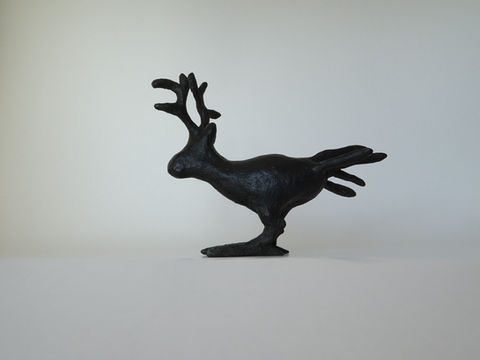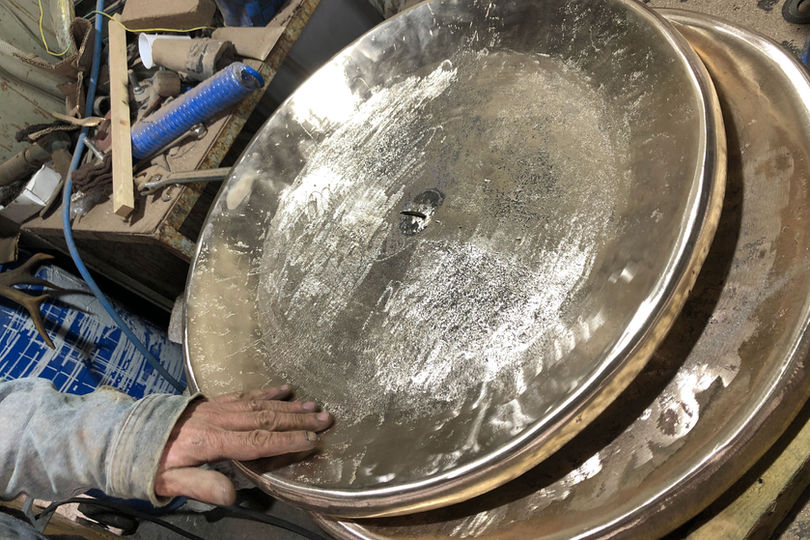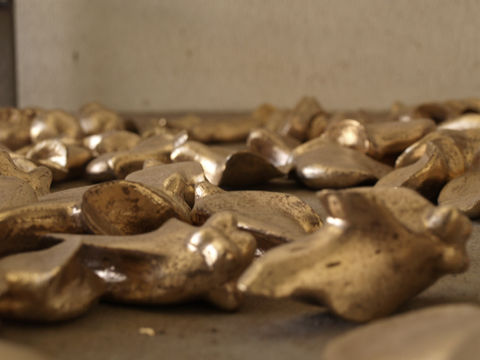
ART FOUNDRY
Art Foundry
Art casting is one of the earliest known processes in the history of working Bronze.
Casting allows complicated shapes to be obtained quickly and economically.
Our origins are linked to lost-wax bronze casting, an activity that we began independently in 2001.
From 2001 to the present, we have been specializing in other casting processes, such as sand casting, and expanding the type of materials we currently cast: Aluminum, Brass or cast iron.
We have also developed capabilities in finishing Bronze and other metals, such as mirror polishing or a wide range of patinas in different colors.
If you have a sculpture that you would like to reproduce in bronze, you can ask us for a quote without obligation.
Lost Wax Casting

01
Lost Wax
We mainly use the lost wax casting process to reproduce sculptures, reliefs and monuments in bronze.
For medium and large sculptures we use the ceramic shell coating process.
For small sculptures we use the “Block Mold” method, which also allows a great degree of detail with shorter production times.
02
Finishing
The Lost Wax Casting process allows for an excellent final finish on the sculptures to be reproduced, an important added value, given that the role of a good caster is to reproduce as faithfully as possible the work of art in their hands.
The lost wax casting process produces parts with a high degree of precision and detail.
03
Materials
We can cast parts from ferrous and non-ferrous materials such as bronze, aluminum, stainless steel or iron.
04
Shapes
Sculptures can have complicated and detailed shapes, such as jewelry, dental prosthetics, all types of parts for machinery and the automotive industry and of course sculptures in bronze or aluminum with the most diverse shapes and sizes.
Sand Casting

01
Sand Casting
For simpler sculptures, without a great degree of detail, we are equipped with equipment to produce sculptures using the chemical sand process.
02
Finishing
The chemical sand casting process uses a chemical binder to unite the sand grains and form the mold and allows parts to be obtained with good dimensional accuracy and surface finish.
03
Materials
It is used to smelt various metals such as iron, steel, aluminum, copper or bronze.
The pieces can have various sizes and complex shapes.
04
Shapes
It is used for the production of automobile components, agricultural machinery, industrial equipment, decorative items, furniture and works of art, such as sculptures, busts, plaques, trophies, etc.
Silicone Molds

01
Silicone molds are essential tools in the world of sculpture and reproduction of pieces.
They allow you to create precise copies of sculptures, decorative objects and other items. Here is some information about silicone molds:
03
Silicone molds are made from a flexible and malleable material such as silicone rubber from an original sculpture in clay, plaster or another equivalent material such as plasticine.
02
Molds are used to create copies of the original wax sculptures.
04
Apart from the lost wax casting process, they are used to create decorative objects such as vases, statues, ornaments and other decorative objects.
Bronze Finish

01
After casting the Bronze, our chisels work on the Bronze (or aluminum, brass, etc.) using a series of techniques and tools.
02
Imperfections and dirt are removed from the surface of the sculptures and if sculptures are cast in several parts, the welds are touched up.
03
The surface finish can take several forms: Patina, or leaving the color of the metal visible.
04
Some customers prefer to polish the surface until it looks like a mirror.
Bronze Alloys

01
Bronze Alloys
We work with various Bronze alloys.
The most common alloy we use is Silicon Bronze.
02
Finishing
!!..We do not use scrap in our Bronze alloys...!!
03
04
Materials
The Bronze Alloys we use are certified.
We use Bronze of Italian origin from a production unit that also supplies other large European artistic foundries.
Upon request we can use other bronze alloys such as: Silver Bronze or White Bronze, Red Bronze or Golden Bronze




Aluminum

01
Use
Aluminum can also be used in artistic casting, although it is most often used in railings for historic buildings, balconies and street furniture due to its lightness and wear resistance making it ideal for use in sculptures and artistic pieces.
02
Weight
Aluminum is a lightweight material, which makes it easier to handle and transport castings.
03
Surface
The surface of cast aluminum is smooth and can be polished to a high-gloss finish.
Aluminum parts can withstand are resistant and can withstand adverse conditions, such as exposure to weather and temperature changes.
04
Cost benefit
The aluminum casting process is relatively cost-efficient, making it accessible to artists and artistic projects.

Brass

01
Use
Brass allows the casting of pieces with great detail and intricate designs.
03
Surface
It is not as resistant as aluminum or bronze, although it has good corrosion resistance.
02
Weight
It is mainly used in small artistic objects such as taps, lighting lamps, handles, jewelry and goldsmithing and also for wall coverings or furniture....
04
Cost benefit
Allows a good surface finish, such as polishing and chiseling.

Iron Cast

01
Use
Cast iron has good corrosion resistance, which makes it suitable for outdoor environments with extreme weather conditions.
Its durability and moldability allow the creation of detailed ornamental pieces
03
Structural Elements
In restoration projects or new construction, cast iron can be used in columns, beams and arches.
Cast Iron Structural Elements add a vintage and historic touch to buildings.
02
Furniture
Cast iron furniture such as tables, chairs and benches are popular in outdoor settings such as gardens and balconies.
04
Ornamental Details
Cast iron is often used in window grilles, handrails and balustrades.
Although less common, cast iron can also be used in doors and windows offering a unique aesthetic and robustness.
Patina

01
Patine is the enhancement of bronze through the chemical application of color.
We have our own patina recipes, which result from a mixture of various chemicals, pigments and different application techniques, creating a wide range of different colors.
The patinas are applied in a specific space in the workshop, and the sculptor can watch the patina being applied to his sculpture.
For those who wish to learn, we also provide support so that the patina can be applied by the sculptor himself in our workshop.
Many sculptors choose to spend the day with us trying out various types of patinas on their sculptures until they are satisfied.
Black Patine
Green Patina
Brown patina














































































